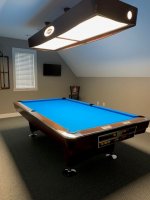If you're going to use incandescent/fluorescent/halogen/etc... ignore _ALL_ this.
CRI for LED is out the door. Gone, see ya. There is general correlations between perception and the index for LED, but that relation is extremely volatile and has been popularly ignored for over a decade. It's still a marketing tool to get a "feel" for which LEDs you're buying, rightfully, but that's it. It's so volatile that the difference between 110v and 220v can cause a color shift that isn't generally noticed by the human eye (unless you have them side by side), but cameras can pick it up. There's a lot of touchy factors for CRI in general and mixing in LED just puts the whole thing on its head. The broadcasting/film companies found this out very early on.
With LED, _visibly_ match somewhere around 4700K (5k is fine), then filter from there (assuming you only want to go warmer from "daylight"). You don't need to know anything else, it's all about what you like anyways. I mean, even if there is a shift, is anyone going to notice let alone care when you light a few different color balls on 1 massive solid color? The brain is going to rationalize the color of the balls from the massive color of the felt anyways.
Lumens to watts is simple, lumens/watts does it, but correlating LED lumens to fluorescent lumens uses the fluorescent as the base black. But as you already know, there's a few considerations to take into account on the LED side to accurately resolve the things like angle, peak, wavelength (others I'm forgetting), so this metric is garbage too. Forget it, just find what is bright enough for you.
It's ridiculously easy to use LEDs in this type of general lighting. There really isn't any better approach than bending up a shaped fixture and adding in LEDs until you're happy. My suggestion is to buy 10 to 15 meters of LED light strips and just keep adding them in _AFTER_ you attached your diffusing film. If you do it before, you might have to rearrange your placing of LEDs to allow for more or less light, and this is a serious pain with or without light strips. But ultimately, the hot spots will fade away and you have a light exactly how you want it.
Unrelated Note:
The picture above demonstrating color temperatures. It is perfectly fine for it's application, but the picture itself was Photoshoped. That doesn't take away from what it's showing you, but you will notice that the shadows have no scaling in color from bouncing light (the photo editor overlooked that), all color shifting was performed in 2D. Was that picture taken with LED or fluorescent? Can't tell, but it was 1 source file that got a little slider love.
CRI for LED is out the door. Gone, see ya. There is general correlations between perception and the index for LED, but that relation is extremely volatile and has been popularly ignored for over a decade. It's still a marketing tool to get a "feel" for which LEDs you're buying, rightfully, but that's it. It's so volatile that the difference between 110v and 220v can cause a color shift that isn't generally noticed by the human eye (unless you have them side by side), but cameras can pick it up. There's a lot of touchy factors for CRI in general and mixing in LED just puts the whole thing on its head. The broadcasting/film companies found this out very early on.
With LED, _visibly_ match somewhere around 4700K (5k is fine), then filter from there (assuming you only want to go warmer from "daylight"). You don't need to know anything else, it's all about what you like anyways. I mean, even if there is a shift, is anyone going to notice let alone care when you light a few different color balls on 1 massive solid color? The brain is going to rationalize the color of the balls from the massive color of the felt anyways.
Lumens to watts is simple, lumens/watts does it, but correlating LED lumens to fluorescent lumens uses the fluorescent as the base black. But as you already know, there's a few considerations to take into account on the LED side to accurately resolve the things like angle, peak, wavelength (others I'm forgetting), so this metric is garbage too. Forget it, just find what is bright enough for you.
It's ridiculously easy to use LEDs in this type of general lighting. There really isn't any better approach than bending up a shaped fixture and adding in LEDs until you're happy. My suggestion is to buy 10 to 15 meters of LED light strips and just keep adding them in _AFTER_ you attached your diffusing film. If you do it before, you might have to rearrange your placing of LEDs to allow for more or less light, and this is a serious pain with or without light strips. But ultimately, the hot spots will fade away and you have a light exactly how you want it.
Unrelated Note:
The picture above demonstrating color temperatures. It is perfectly fine for it's application, but the picture itself was Photoshoped. That doesn't take away from what it's showing you, but you will notice that the shadows have no scaling in color from bouncing light (the photo editor overlooked that), all color shifting was performed in 2D. Was that picture taken with LED or fluorescent? Can't tell, but it was 1 source file that got a little slider love.

